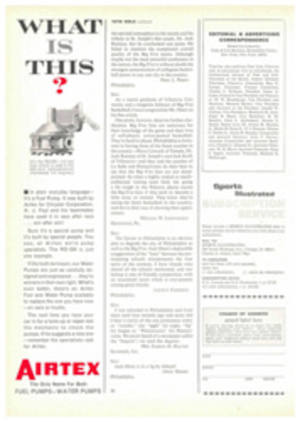
A bird named Lady—or Lyndon
Never has so much international solicitude been lavished upon a single wild bird as that being heaped upon a battered, bedraggled and accident-prone baby whooping crane named Lady Bird. This 6-month-old fledgling, still in its rusty-brown juvenile plumage, has received nothing but VIB treatment since it first staggered out of its nest, and concern for the injured youngster can only continue to increase. It now represents the beginning of a long-range program of the U.S. Fish and Wildlife Service to rear whooping cranes in captivity with the ultimate aim of augmenting the small remaining wild flock.
The first accident occurred four months ago when, in learning to fly near its birthplace in Canada's north country, the awkward nestling crash-landed on a burned tree stub, suffering injuries that may have deprived it of flight forever. Millions of birds flutter to their deaths unnoticed by man, but this young whooper was in luck. A Canadian Wildlife Service plane on its weekly patrol of the whoopers' nesting grounds in the wilderness south of Great Slave Lake spotted the bird with its dragging wing.
This started a chain reaction reaching from Canada to Washington and on to Colorado, with repercussions extending all the way to Florida. Normally whooping cranes fly almost 2,500 miles on their annual migration to the Texas coast, but this youngster found itself the sole passenger aboard a government plane winging toward the Rocky Mountains.
Upon receipt of the report of a whooper down in the wilderness, Canadian Wildlife Service officials dispatched a helicopter. The rescue was effected as the rest of the family, the parents and other young birds, flew away. At Fort Smith, an outpost on the Slave River, the whooper was transferred to a commercial plane that flew it to Edmonton, Alta. Dr. Ward E. Stevens, Western Regional Superintendent of the Canadian Wildlife Service, met the bird there and hustled it to a veterinary clinic.
A group of veterinarians went to work administering antibiotics and other remedies normally foreign to wild birds. X rays disclosed a two-inch sliver of charred wood lodged in the left side of the breast and a fractured right humerus, evidently suffered as the bird struggled to free itself from the stub. The broken wing was set and the bird trussed up.
Meanwhile, word had reached Ottawa. Ottawa notified Washington. Washington acknowledged and sent word to Denver. Edward G. Wellein, then chief of the section of Migratory Bird Population Studies, and Eugene Knoder, research biologist in charge of the whooping crane rearing project, started north in a Cessna 180. By the time they reached Edmonton the crane was on the way to recovery, although its broken wing was still bound tight to its body, making it resemble a stork that had become wrapped in its own delivery diaper. Despite its numerous setbacks, the bird met the Americans with that solemn dignity that is characteristic of all whoopers.
Knoder was surprised by the bird's tameness and confiding behavior. "She allowed herself to be approached closely, and fed readily from my hand," he said later. "In general she acted as though human beings were nothing but other cranes. If this behavior is typical of young whoopers, it must mean that they learn fear of humans from their parents during their southward migration and on the wintering grounds."
Packing the friendly bird in a large cardboard box, Wellein and Knoder took off in the Cessna for Colorado. Word of the crane's adventures already had reached the States, and as it approached Cut Bank, Mont., where the plane was to clear U.S. Customs, the first thing the man in the control tower said was, "How's the patient?"
On the ground, when he took the bird out of the carton for a little exercise, Knoder immediately became the day's feature attraction. He started to hustle his crane back into the plane to avoid the gathering crowd, but the whooper calmly began eating and drinking while the spectators used up film at a great rate. One woman held her child up to see, saying, "Take a good look, because it may be the last time you'll ever see a whooping crane." This nettled Knoder a bit, because the main purpose of his project is to keep the cranes flying.
Arriving at the Monte Vista National Wildlife Refuge in south central Colorado, the crane was installed in a heated room at the research center. All went well for two weeks, but suddenly the bird became weak, was barely able to stand and refused to eat or drink. Once more veterinarians and bird experts came to the rescue. The whooper rallied to their treatment and soon was taking morning exercise outside its quarters.
During one of these early morning capers the youngster caught a toe in the bandage and fell heavily, suffering a compound fracture of the already injured wing. Once more the bones were set, and the durable bird, already accustomed to being wrapped like a mummy, faced another six weeks of bandages.
"If we can just suppress her exuberant spirits long enough to get that wing completely healed, we will have one more whooper to place in the ranks of those battling against extinction," Knoder said. Meanwhile, the Knoders' two children, Erik, 9, and Shawn, 11, have become very fond of the young crane and watch it for long periods. They have named it Lady Bird, but that is tentative. After an expert comes from Washington to determine the bird's sex the name may have to be changed to Lyndon Bird. However, the whole family is hoping it's a girl.
Being the only whooper on the refuge, Lady Bird has to be content with living in pens otherwise containing only common-variety sandhill cranes, which Knoder has hatched and reared in pilot experiments that will lead to the rearing of whoopers in captivity. If all goes well with the sandhill crane experiments, the Fish and Wildlife Service intends to take eggs from the nests of wild whoopers to start the program.
This part of the plan already has brought protests. The National Audubon Society, long active in protecting the whooping cranes, is flatly opposed to the taking of eggs from the nests, on the ground that nothing should be done that might endanger the meager wild population. Down in Florida, Alexander Sprunt IV, research director of the National Audubon Society, said they were not opposed to raising whoopers in captivity but were against taking eggs from the wild birds in Canada.
As if they were aware of the controversy over their welfare, the wild flock, which numbered 32 when it went north last spring, returned to the Texas coast this fall with 10 young, the greatest number they have brought back since officials started counting them in 1939. Had Lady Bird not run afoul of that burned tree she would have made No. 11. This brings the world whooping crane population to 50: 42 wild birds, seven in the New Orleans zoo and Lady Bird. The Fish and Wildlife Service is seeking to utilize eggs from those captives in its program but says more are needed.
Back in Colorado the young whooper, now four and a half feet tall, gazes out to the snow-covered mountains and continues to improve. The other day Knoder removed the bandage, and the wing, though droopy, appears to have knit well. Only time will tell whether Lady Bird will fly again. The success or failure of the artificial restoration program lies some years in the future, but things have not looked so good for the whooping crane for almost half a century.
PHOTO
INJURED WHOOPER is carefully examined by Research Biologist Eugene Knoder.

